2017 NISSAN LEAF stop start
[x] Cancel search: stop startPage 64 of 424
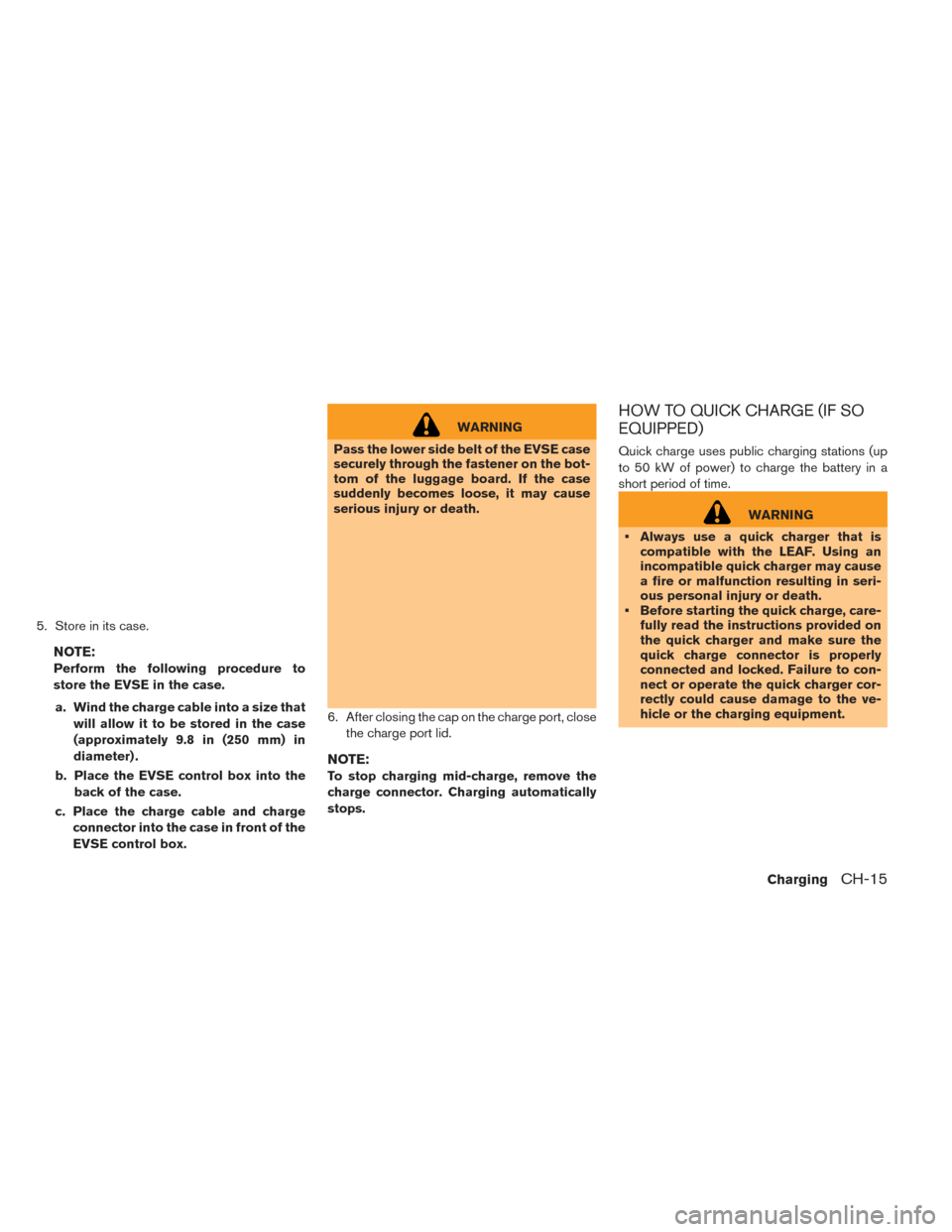
5. Store in its case.
NOTE:
Perform the following procedure to
store the EVSE in the case.a. Wind the charge cable into a size that will allow it to be stored in the case
(approximately 9.8 in (250 mm) in
diameter) .
b. Place the EVSE control box into the back of the case.
c. Place the charge cable and charge connector into the case in front of the
EVSE control box.
WARNING
Pass the lower side belt of the EVSE case
securely through the fastener on the bot-
tom of the luggage board. If the case
suddenly becomes loose, it may cause
serious injury or death.
6. After closing the cap on the charge port, close the charge port lid.
NOTE:
To stop charging mid-charge, remove the
charge connector. Charging automatically
stops.
HOW TO QUICK CHARGE (IF SO
EQUIPPED)
Quick charge uses public charging stations (up
to 50 kW of power) to charge the battery in a
short period of time.
WARNING
• Always use a quick charger that is compatible with the LEAF. Using an
incompatible quick charger may cause
a fire or malfunction resulting in seri-
ous personal injury or death.
• Before starting the quick charge, care- fully read the instructions provided on
the quick charger and make sure the
quick charge connector is properly
connected and locked. Failure to con-
nect or operate the quick charger cor-
rectly could cause damage to the ve-
hicle or the charging equipment.
ChargingCH-15
Page 66 of 424
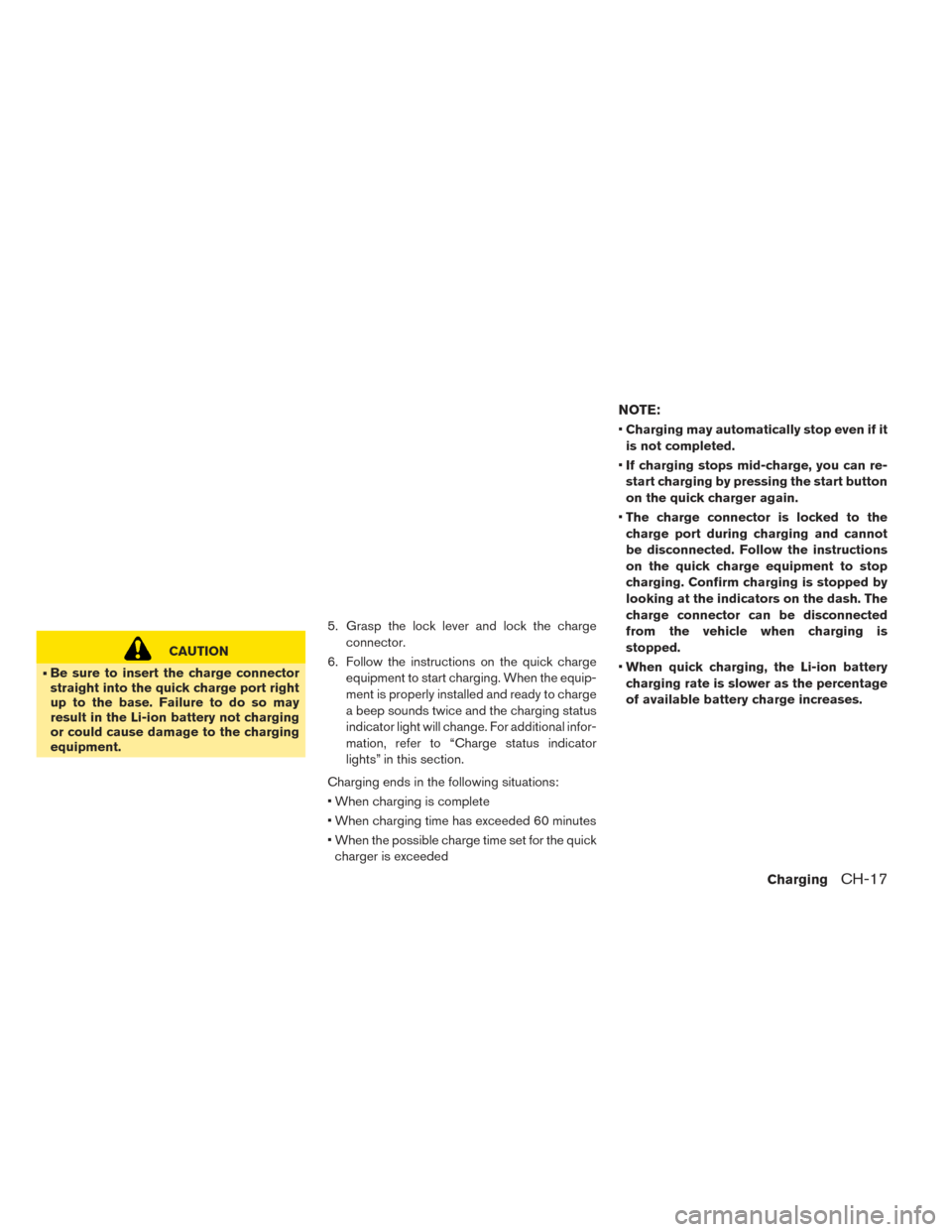
CAUTION
• Be sure to insert the charge connector
straight into the quick charge port right
up to the base. Failure to do so may
result in the Li-ion battery not charging
or could cause damage to the charging
equipment. 5. Grasp the lock lever and lock the charge
connector.
6. Follow the instructions on the quick charge equipment to start charging. When the equip-
ment is properly installed and ready to charge
a beep sounds twice and the charging status
indicator light will change. For additional infor-
mation, refer to “Charge status indicator
lights” in this section.
Charging ends in the following situations:
• When charging is complete
• When charging time has exceeded 60 minutes
• When the possible charge time set for the quick charger is exceeded
NOTE:
•Charging may automatically stop even if it
is not completed.
• If charging stops mid-charge, you can re-
start charging by pressing the start button
on the quick charger again.
• The charge connector is locked to the
charge port during charging and cannot
be disconnected. Follow the instructions
on the quick charge equipment to stop
charging. Confirm charging is stopped by
looking at the indicators on the dash. The
charge connector can be disconnected
from the vehicle when charging is
stopped.
• When quick charging, the Li-ion battery
charging rate is slower as the percentage
of available battery charge increases.
ChargingCH-17
Page 71 of 424
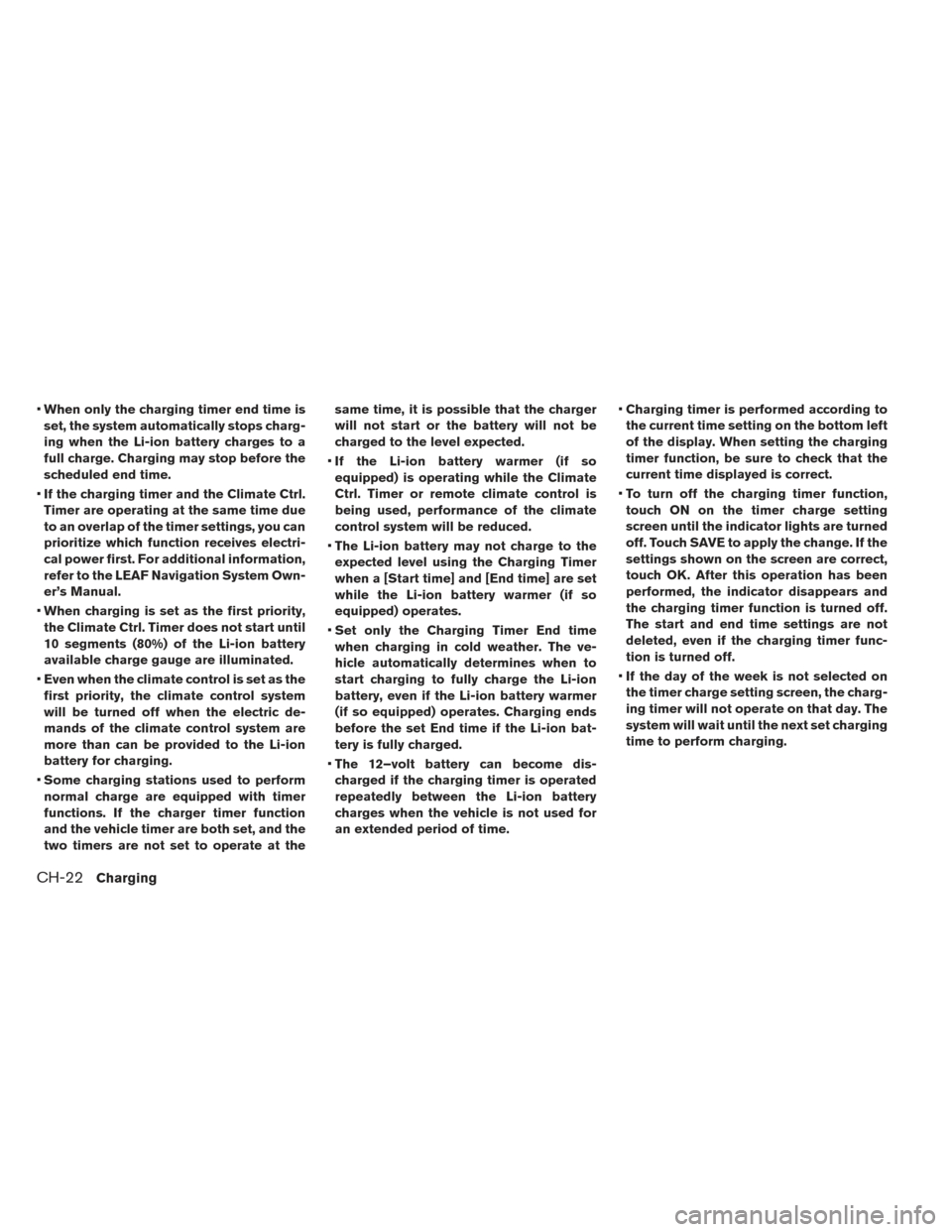
•When only the charging timer end time is
set, the system automatically stops charg-
ing when the Li-ion battery charges to a
full charge. Charging may stop before the
scheduled end time.
• If the charging timer and the Climate Ctrl.
Timer are operating at the same time due
to an overlap of the timer settings, you can
prioritize which function receives electri-
cal power first. For additional information,
refer to the LEAF Navigation System Own-
er’s Manual.
• When charging is set as the first priority,
the Climate Ctrl. Timer does not start until
10 segments (80%) of the Li-ion battery
available charge gauge are illuminated.
• Even when the climate control is set as the
first priority, the climate control system
will be turned off when the electric de-
mands of the climate control system are
more than can be provided to the Li-ion
battery for charging.
• Some charging stations used to perform
normal charge are equipped with timer
functions. If the charger timer function
and the vehicle timer are both set, and the
two timers are not set to operate at the same time, it is possible that the charger
will not start or the battery will not be
charged to the level expected.
• If the Li-ion battery warmer (if so
equipped) is operating while the Climate
Ctrl. Timer or remote climate control is
being used, performance of the climate
control system will be reduced.
• The Li-ion battery may not charge to the
expected level using the Charging Timer
when a [Start time] and [End time] are set
while the Li-ion battery warmer (if so
equipped) operates.
• Set only the Charging Timer End time
when charging in cold weather. The ve-
hicle automatically determines when to
start charging to fully charge the Li-ion
battery, even if the Li-ion battery warmer
(if so equipped) operates. Charging ends
before the set End time if the Li-ion bat-
tery is fully charged.
• The 12–volt battery can become dis-
charged if the charging timer is operated
repeatedly between the Li-ion battery
charges when the vehicle is not used for
an extended period of time. •
Charging timer is performed according to
the current time setting on the bottom left
of the display. When setting the charging
timer function, be sure to check that the
current time displayed is correct.
• To turn off the charging timer function,
touch ON on the timer charge setting
screen until the indicator lights are turned
off. Touch SAVE to apply the change. If the
settings shown on the screen are correct,
touch OK. After this operation has been
performed, the indicator disappears and
the charging timer function is turned off.
The start and end time settings are not
deleted, even if the charging timer func-
tion is turned off.
• If the day of the week is not selected on
the timer charge setting screen, the charg-
ing timer will not operate on that day. The
system will wait until the next set charging
time to perform charging.
CH-22Charging
Page 72 of 424
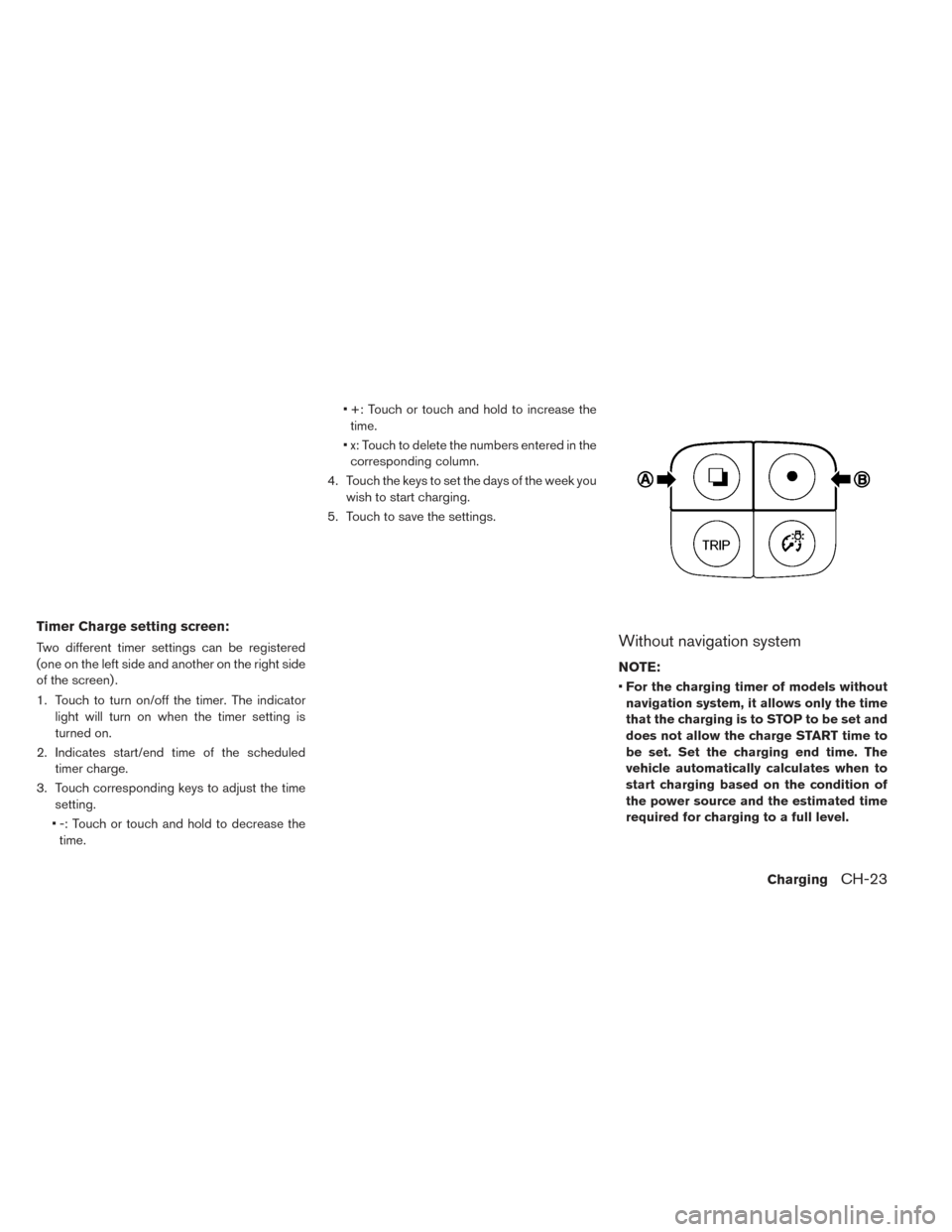
Timer Charge setting screen:
Two different timer settings can be registered
(one on the left side and another on the right side
of the screen) .
1. Touch to turn on/off the timer. The indicatorlight will turn on when the timer setting is
turned on.
2. Indicates start/end time of the scheduled timer charge.
3. Touch corresponding keys to adjust the time setting.
• -: Touch or touch and hold to decrease the time. • +: Touch or touch and hold to increase the
time.
• x: Touch to delete the numbers entered in the corresponding column.
4. Touch the keys to set the days of the week you wish to start charging.
5. Touch to save the settings.Without navigation system
NOTE:
• For the charging timer of models without
navigation system, it allows only the time
that the charging is to STOP to be set and
does not allow the charge START time to
be set. Set the charging end time. The
vehicle automatically calculates when to
start charging based on the condition of
the power source and the estimated time
required for charging to a full level.
ChargingCH-23
Page 81 of 424
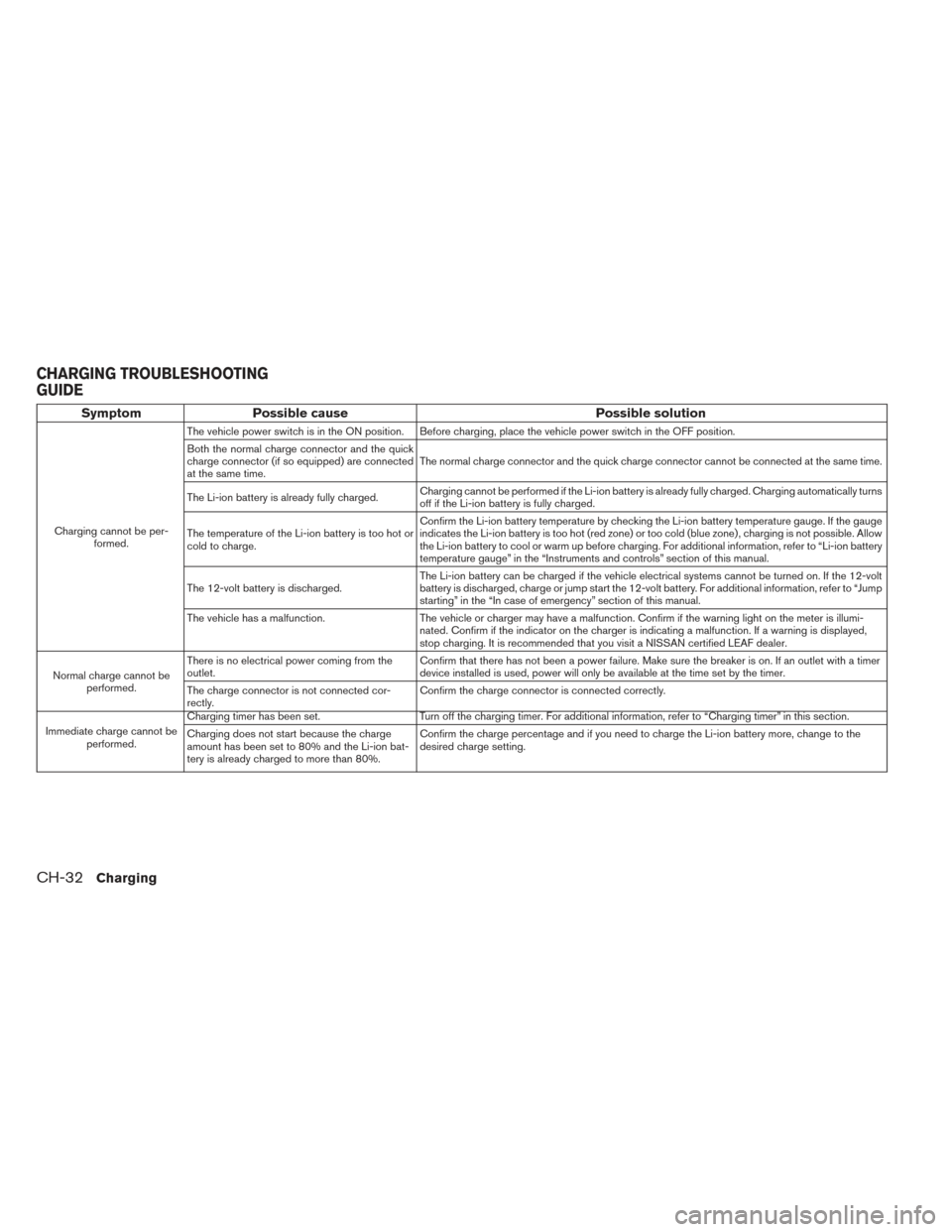
SymptomPossible cause Possible solution
Charging cannot be per-
formed. The vehicle power switch is in the ON position. Before charging, place the vehicle power switch in the OFF position.
Both the normal charge connector and the quick
charge connector (if so equipped) are connected
at the same time.
The normal charge connector and the quick charge connector cannot be connected at the same time.
The Li-ion battery is already fully charged. Charging cannot be performed if the Li-ion battery is already fully charged. Charging automatically turns
off if the Li-ion battery is fully charged.
The temperature of the Li-ion battery is too hot or
cold to charge. Confirm the Li-ion battery temperature by checking the Li-ion battery temperature gauge. If the gauge
indicates the Li-ion battery is too hot (red zone) or too cold (blue zone) , charging is not possible. Allow
the Li-ion battery to cool or warm up before charging. For additional information, refer to “Li-ion battery
temperature gauge” in the “Instruments and controls” section of this manual.
The 12-volt battery is discharged. The Li-ion battery can be charged if the vehicle electrical systems cannot be turned on. If the 12-volt
battery is discharged, charge or jump start the 12-volt battery. For additional information, refer to “Jump
starting” in the “In case of emergency” section of this manual.
The vehicle has a malfunction. The vehicle or charger may have a malfunction. Confirm if the warning light on the meter is illumi-
nated. Confirm if the indicator on the charger is indicating a malfunction. If a warning is displayed,
stop charging. It is recommended that you visit a NISSAN certified LEAF dealer.
Normal charge cannot be performed. There is no electrical power coming from the
outlet.
Confirm that there has not been a power failure. Make sure the breaker is on. If an outlet with a timer
device installed is used, power will only be available at the time set by the timer.
The charge connector is not connected cor-
rectly. Confirm the charge connector is connected correctly.
Immediate charge cannot be
performed. Charging timer has been set. Turn off the charging timer. For additional information, refer to “Charging timer” in this section.
Charging does not start because the charge
amount has been set to 80% and the Li-ion bat-
tery is already charged to more than 80%.
Confirm the charge percentage and if you need to charge the Li-ion battery more, change to the
desired charge setting.
CHARGING TROUBLESHOOTING
GUIDE
CH-32Charging
Page 83 of 424
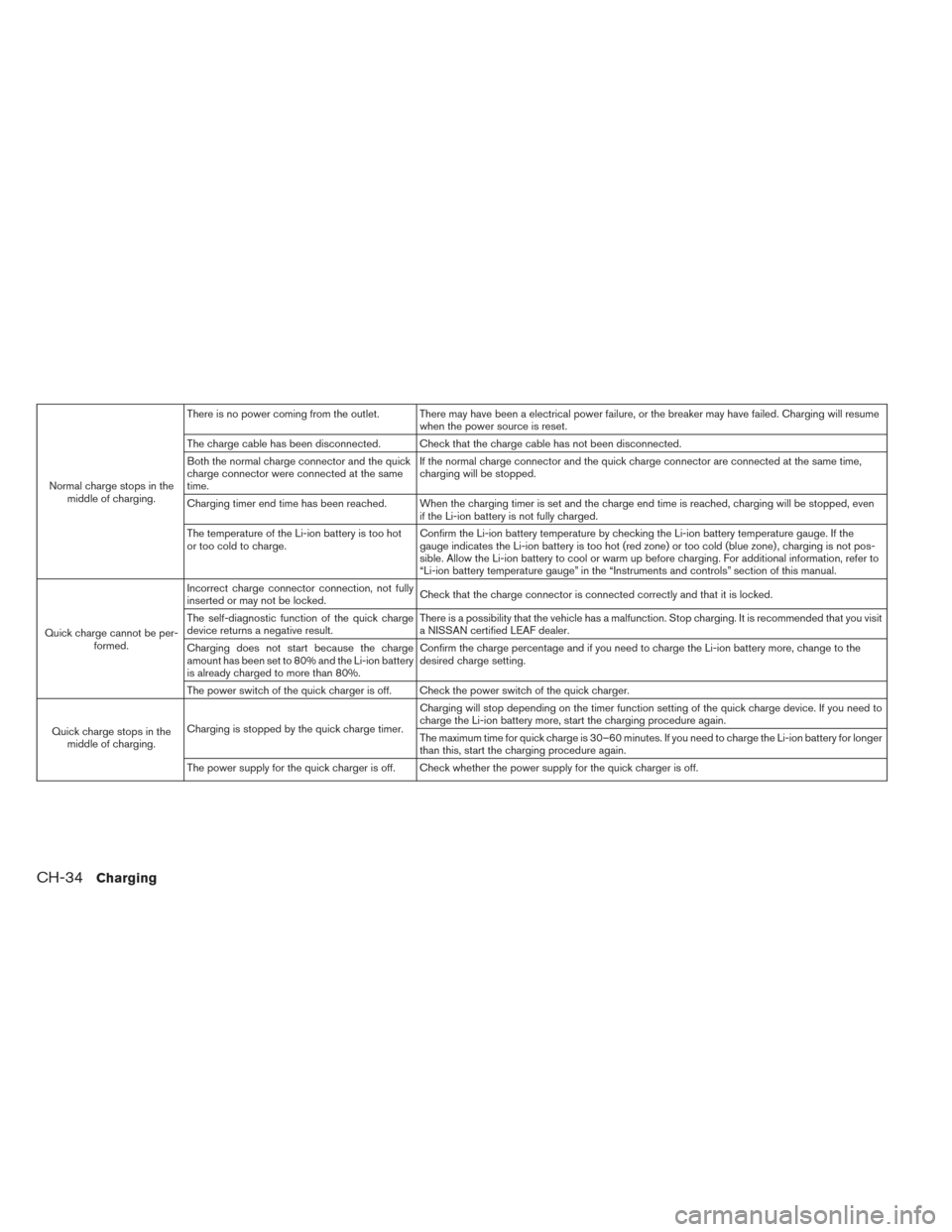
Normal charge stops in themiddle of charging. There is no power coming from the outlet. There may have been a electrical power failure, or the breaker may have failed. Charging will resume
when the power source is reset.
The charge cable has been disconnected. Check that the charge cable has not been disconnected.
Both the normal charge connector and the quick
charge connector were connected at the same
time. If the normal charge connector and the quick charge connector are connected at the same time,
charging will be stopped.
Charging timer end time has been reached. When the charging timer is set and the charge end time is reached, charging will be stopped, even if the Li-ion battery is not fully charged.
The temperature of the Li-ion battery is too hot
or too cold to charge. Confirm the Li-ion battery temperature by checking the Li-ion battery temperature gauge. If the
gauge indicates the Li-ion battery is too hot (red zone) or too cold (blue zone) , charging is not pos-
sible. Allow the Li-ion battery to cool or warm up before charging. For additional information, refer to
“Li-ion battery temperature gauge” in the “Instruments and controls” section of this manual.
Quick charge cannot be per- formed. Incorrect charge connector connection, not fully
inserted or may not be locked.
Check that the charge connector is connected correctly and that it is locked.
The self-diagnostic function of the quick charge
device returns a negative result. There is a possibility that the vehicle has a malfunction. Stop charging. It is recommended that you visit
a NISSAN certified LEAF dealer.
Charging does not start because the charge
amount has been set to 80% and the Li-ion battery
is already charged to more than 80%. Confirm the charge percentage and if you need to charge the Li-ion battery more, change to the
desired charge setting.
The power switch of the quick charger is off. Check the power switch of the quick charger.
Quick charge stops in the middle of charging. Charging is stopped by the quick charge timer. Charging will stop depending on the timer function setting of the quick charge device. If you need to
charge the Li-ion battery more, start the charging procedure again.
The maximum time for quick charge is 30–60 minutes. If you need to charge the Li-ion battery for longer
than this, start the charging procedure again.
The power supply for the quick charger is off. Check whether the power supply for the quick charger is off.
CH-34Charging
Page 133 of 424
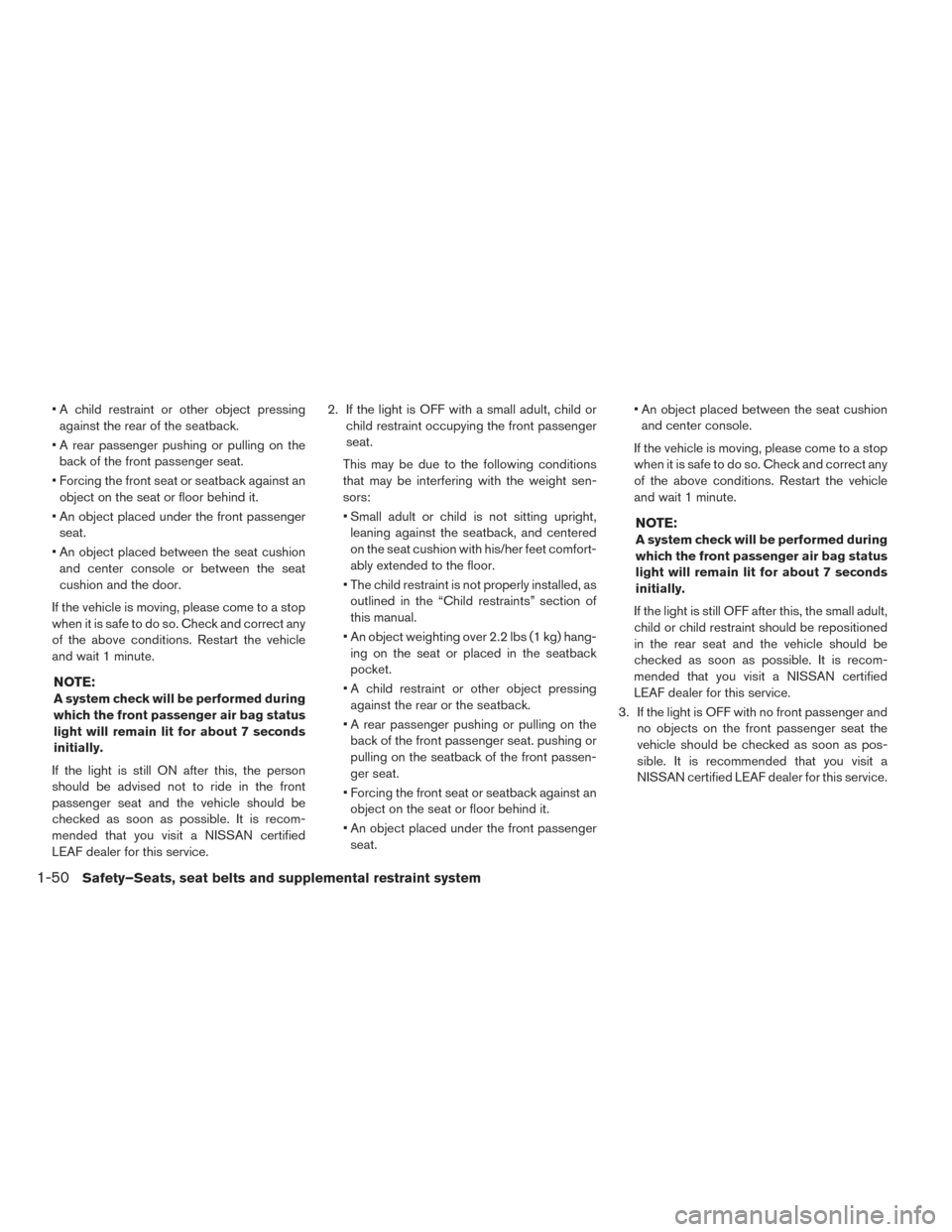
• A child restraint or other object pressingagainst the rear of the seatback.
• A rear passenger pushing or pulling on the back of the front passenger seat.
• Forcing the front seat or seatback against an object on the seat or floor behind it.
• An object placed under the front passenger seat.
• An object placed between the seat cushion and center console or between the seat
cushion and the door.
If the vehicle is moving, please come to a stop
when it is safe to do so. Check and correct any
of the above conditions. Restart the vehicle
and wait 1 minute.
NOTE:
A system check will be performed during
which the front passenger air bag status
light will remain lit for about 7 seconds
initially.
If the light is still ON after this, the person
should be advised not to ride in the front
passenger seat and the vehicle should be
checked as soon as possible. It is recom-
mended that you visit a NISSAN certified
LEAF dealer for this service. 2. If the light is OFF with a small adult, child or
child restraint occupying the front passenger
seat.
This may be due to the following conditions
that may be interfering with the weight sen-
sors:
• Small adult or child is not sitting upright, leaning against the seatback, and centered
on the seat cushion with his/her feet comfort-
ably extended to the floor.
• The child restraint is not properly installed, as outlined in the “Child restraints” section of
this manual.
• An object weighting over 2.2 lbs (1 kg) hang- ing on the seat or placed in the seatback
pocket.
• A child restraint or other object pressing against the rear or the seatback.
• A rear passenger pushing or pulling on the back of the front passenger seat. pushing or
pulling on the seatback of the front passen-
ger seat.
• Forcing the front seat or seatback against an object on the seat or floor behind it.
• An object placed under the front passenger seat. • An object placed between the seat cushion
and center console.
If the vehicle is moving, please come to a stop
when it is safe to do so. Check and correct any
of the above conditions. Restart the vehicle
and wait 1 minute.
NOTE:
A system check will be performed during
which the front passenger air bag status
light will remain lit for about 7 seconds
initially.
If the light is still OFF after this, the small adult,
child or child restraint should be repositioned
in the rear seat and the vehicle should be
checked as soon as possible. It is recom-
mended that you visit a NISSAN certified
LEAF dealer for this service.
3. If the light is OFF with no front passenger and no objects on the front passenger seat the
vehicle should be checked as soon as pos-
sible. It is recommended that you visit a
NISSAN certified LEAF dealer for this service.
1-50Safety–Seats, seat belts and supplemental restraint system
Page 152 of 424
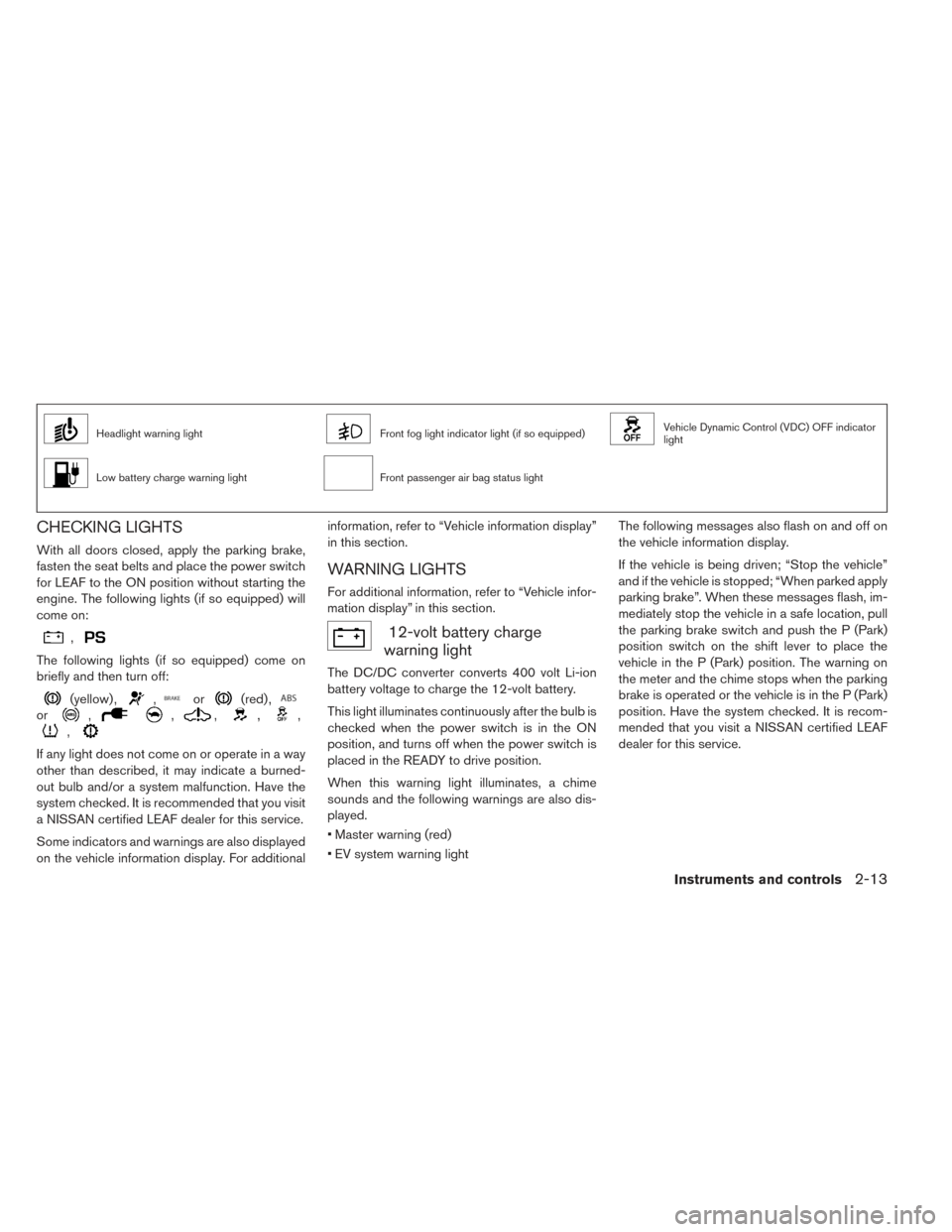
Headlight warning lightFront fog light indicator light (if so equipped)Vehicle Dynamic Control (VDC) OFF indicator
light
Low battery charge warning lightFront passenger air bag status light
CHECKING LIGHTS
With all doors closed, apply the parking brake,
fasten the seat belts and place the power switch
for LEAF to the ON position without starting the
engine. The following lights (if so equipped) will
come on:
,
The following lights (if so equipped) come on
briefly and then turn off:
(yellow) ,,or(red) ,
or,,,,,
,
If any light does not come on or operate in a way
other than described, it may indicate a burned-
out bulb and/or a system malfunction. Have the
system checked. It is recommended that you visit
a NISSAN certified LEAF dealer for this service.
Some indicators and warnings are also displayed
on the vehicle information display. For additionalinformation, refer to “Vehicle information display”
in this section.
WARNING LIGHTS
For additional information, refer to “Vehicle infor-
mation display” in this section.
12-volt battery charge
warning light
The DC/DC converter converts 400 volt Li-ion
battery voltage to charge the 12-volt battery.
This light illuminates continuously after the bulb is
checked when the power switch is in the ON
position, and turns off when the power switch is
placed in the READY to drive position.
When this warning light illuminates, a chime
sounds and the following warnings are also dis-
played.
• Master warning (red)
• EV system warning light The following messages also flash on and off on
the vehicle information display.
If the vehicle is being driven; “Stop the vehicle”
and if the vehicle is stopped; “When parked apply
parking brake”. When these messages flash, im-
mediately stop the vehicle in a safe location, pull
the parking brake switch and push the P (Park)
position switch on the shift lever to place the
vehicle in the P (Park) position. The warning on
the meter and the chime stops when the parking
brake is operated or the vehicle is in the P (Park)
position. Have the system checked. It is recom-
mended that you visit a NISSAN certified LEAF
dealer for this service.
Instruments and controls2-13